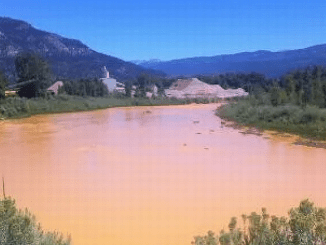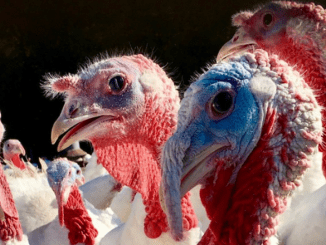
CRAIG, Colorado, March 23, 2023 (ENS) – The nonprofit Wild Animal Sanctuary has just acquired a large piece of land in northwest Colorado near the historic town of Steamboat Springs and is turning it into one of the largest free-roaming wild horse sanctuaries in the United States.
The Wild Animal Sanctuary bought the land for its newly created Wild Horse Refuge, which will serve to rescue and protect hundreds of Colorado’s native wild horses, Mustangs. With more than 22,450 acres of land spanning 29 square miles, the new refuge is larger than the island of Manhattan.
Denver is located 4.5 hours southeast of the new Wild Horse Refuge, while Salt Lake City, Utah is four hours to the west.
The refuge is being created in response to the Bureau of Land Management’s (BLM) controversial wild horse round up operations which began in early 2022 and were done within Colorado’s Sand Wash Basin and Piceance-East Douglas Herd Management Areas, the Sanctuary says.
The BLM manages the Sand Wash Basin Herd Area west of Craig for up to 362 wild horses, but the current population exceeds 600, a number that poses a serious risk to the area’s ecological balance, according to the agency.
After captured wild horses held in pens on state prison grounds in Cañon City suffered the deadliest mustang flu outbreak on record last spring, Governor Jared Polis, a Democrat, wrote to the BLM asking them to call off scheduled roundups and work with the state on a gentler solution to the abundance of horses on public lands. His request was declined by the federal agency.
Determined to cut the size of the Mustang herds, this year the BLM is investing $625,000 in the Sand Wash Basin Herd Management Area to manage the number of wild horses there through the use of fertility controls and removals of “excess animals” using bait traps.
Also, BLM’s White River Field Office is working on getting a better population size estimate for the Piceance-East Douglas herd in Rio Blanco County after last year’s major roundup and removal.
The Bureau of Land Management ran what they call a “horse gather” in the area that began with bait and water trap operations on June 16, 2022 and shifted to a drive-trap gather operations using a helicopter July 15. By July 27, the BLM had rounded up 733 horses: 271 stallions, 326 mares and 136 foals.
BLM officials believe the horse numbers there are still several hundred above their management goals, the “Grand Junction Daily Sentinel” reports.
If left unchecked, wild horse populations can double in four or five years, BLM spokesman Steven Hall told the newspaper.
The wild horses gathered by the BLM are made available for adoption, and an Adoption Incentive Program provides up to $1,000 to adopt an untrained wild horse or burro from the BLM.
Wild Animal Sanctuary’s Vast New Refuge
Formerly known as the Rio Ro Mo Ranch, the new refuge land was once used for cattle ranching and breeding, but it will now be dedicated entirely to saving Colorado’s native wild horses, the Santuary said.
The landscape of rolling hills and canyons covered in native grasses, sagebrush and juniper trees, with Lay Creek providing water, will enable the wild Mustangs to live and roam freely.
The newly formed refuge is already inhabited by mountain lions, bobcats, deer, elk, pronghorn antelope, doves, sage grouse, geese, ducks, golden and bald eagles. The Sanctuary says that as the refuge moves forward in the coming months, there are plans to rescue and provide a life-long home to as many as 500 head of wild Mustangs.
The Wild Animal Sanctuary has been rescuing captive wildlife, horses and many other species of animals for more than 43 years and currently operates three other facilities for rescued animals.
With a 1,214-acre facility located near Denver, Colorado as well as a second 10,000-acre facility located in southeast Colorado, and a third facility located just west of Fort Worth, Texas – total acreage for the organization now amounts to more than 33,000 acres.
Located near Keenesburg, Colorado, the Wild Animal Sanctuary is the largest nonprofit carnivore sanctuary in the world, with over 650 rescued animals, including lions, tigers, bears, wolves, leopards, and other large carnivores living in large-acreage natural habitats.
Last September the Sanctuary rescued nine lions from the war in Ukraine, the largest war zone rescue of lions ever carried out.
The pride of lions had been living at the Bio Park Zoo in Odessa, a southern port in Ukraine devastated by invading Russian military forces.
The big cats were urgently relocated when the war first broke by a convoy that journeyed over 600 miles across Ukraine and Moldova, arriving in Targu Mures, Romania, on May 24, 2022. The Targu Mures Zoo was a temporary home for the lions for several months until an emergency travel permit could be approved for 11 lions to board an international rescue flight.
From the rescued group of big cats, seven adult lions and two cubs have a new forever home at The Wild Animal Refuge, an extension property of The Wild Animal Sanctuary. The remaining two lions went to the Simbonga Game Reserve and Sanctuary in the Eastern Cape, South Africa.
The rescue mission involved a consortium of global animal welfare agencies working together, including Greater Good, The Global Federation of Animal Sanctuaries, Tigers in America, Warriors of Wildlife, and the Simbonga Wildlife Sanctuary in South Africa.
“International rescue operations are almost always more complex in nature, but then you are factoring in a variety of foreign governments and timelines for permitting, some of those with active war zones. We are thankful we could get all the lions out in time and save them. That’s what matters. They will live out the rest of their lives in pristine, large, natural habitats,” Executive Director of The Wild Animal Sanctuary Pat Craig said.
Established in 1980, the Sanctuary operates three locations with more than 10,000 acres for abused, abandoned, and confiscated carnivores and specializes in rehabilitating captive wildlife so they can be released into natural habitats where they can roam freely and live with others of their own kind.
For more information about The Wild Animal Sanctuary or its Wild Horse Refuge, visit WildAnimalSanctuary.org or WildHorseRefuge.org.
Featured image: Wild Mustangs in the Piceance-East Douglas Herd Management Area, one of four HMAs in Colorado. (Photo by David Boyd courtesy Bureau of Land Management)



